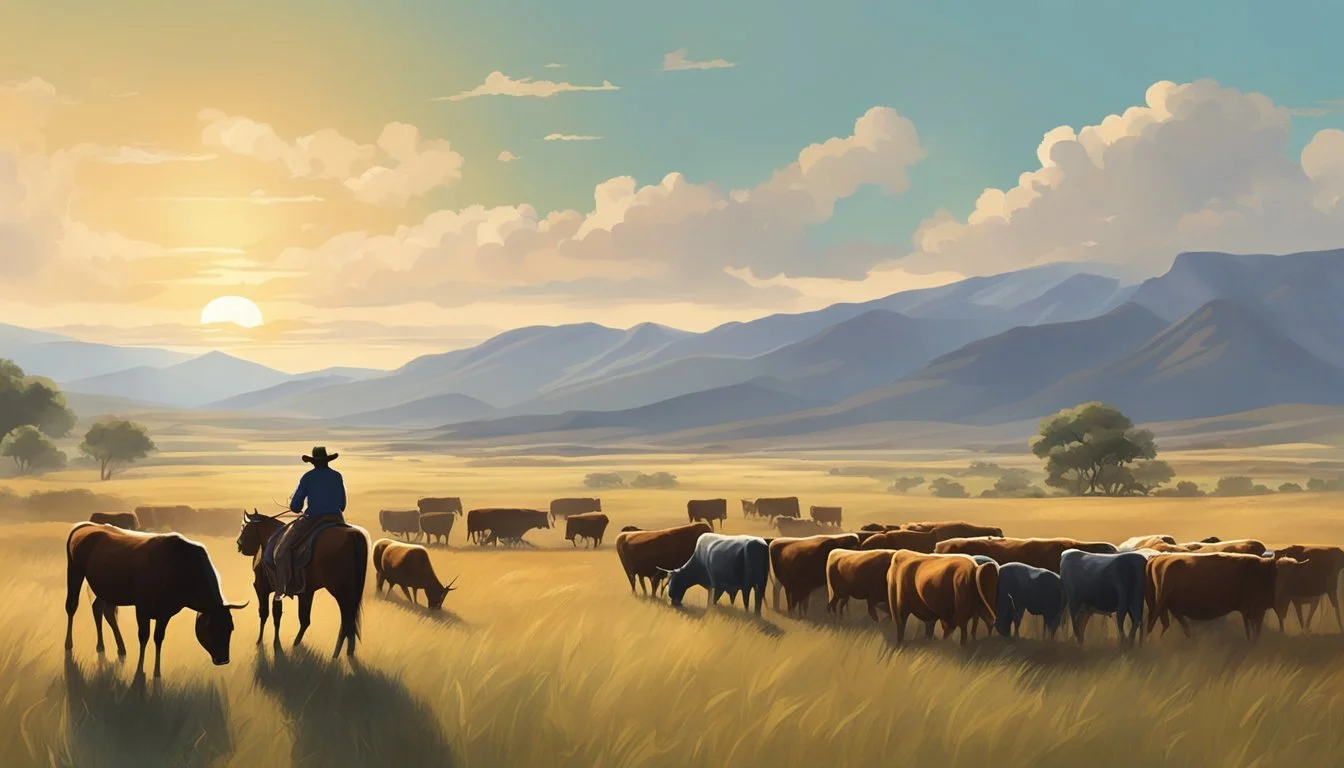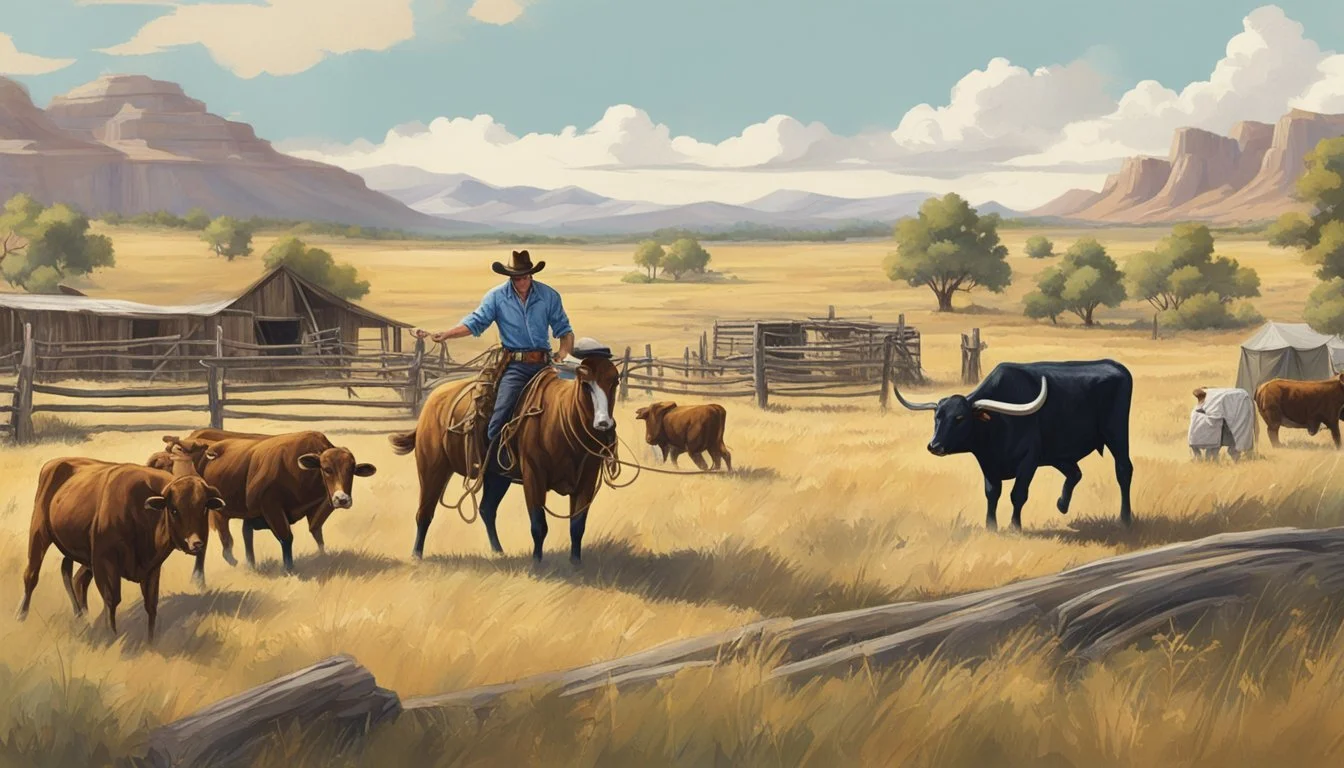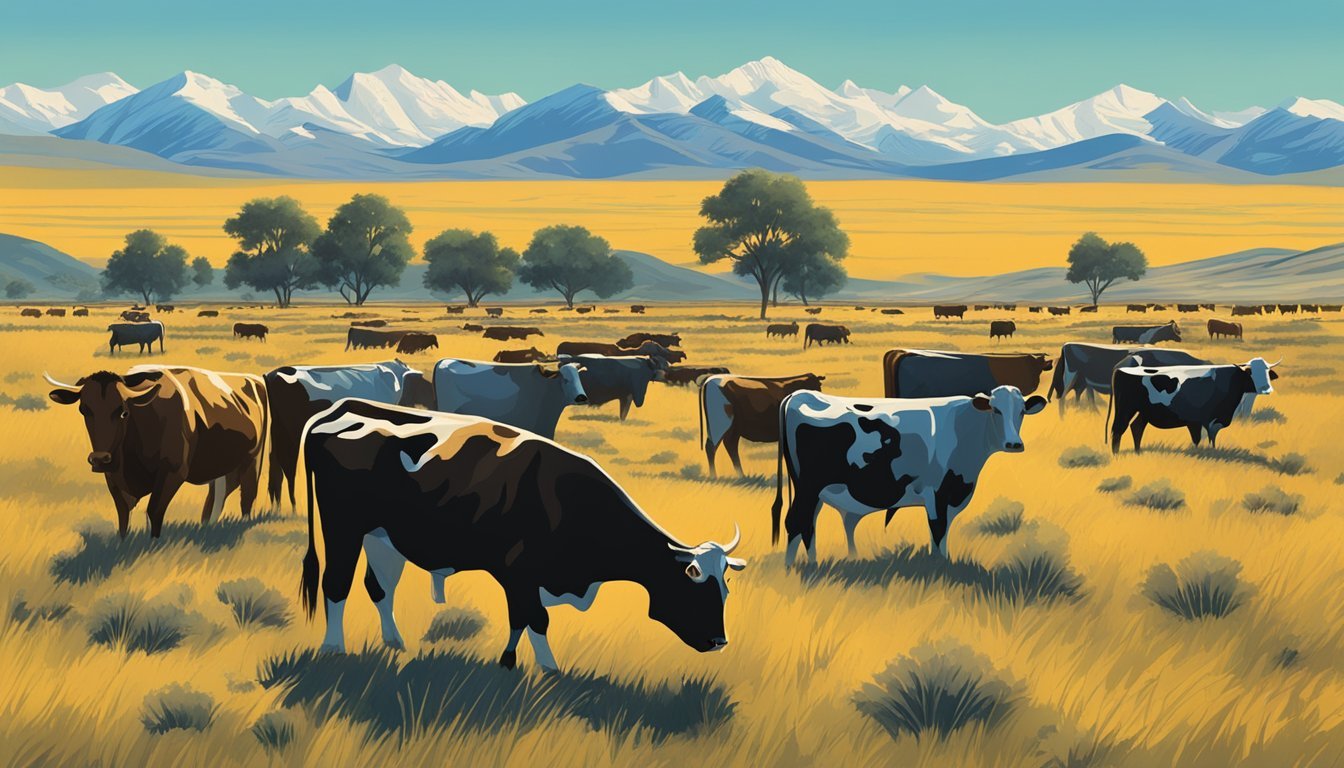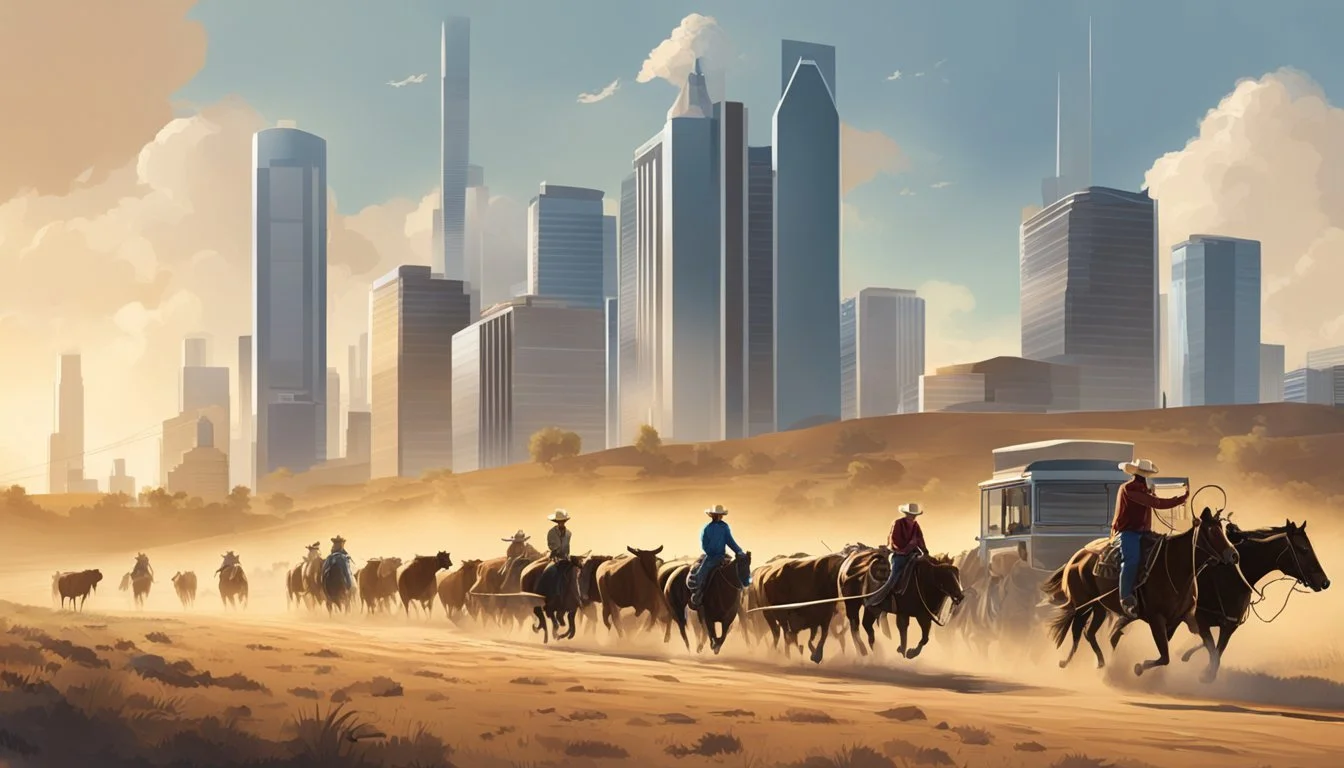The Importance of Livestock to Cowboy Culture
Tradition and Identity
Cowboy culture in the American West is inextricably tied to the raising and handling of livestock, a tradition that has shaped not only the economic activities of the region but also its social fabric and folklore. The cowboys, often seen as rugged icons of the frontier, were originally tasked with tending to cattle and horses, making livestock the very foundation upon which their way of life was built. It was through the challenges of handling herds on open rangelands, driving cattle across vast territories, and the intimate knowledge required to manage these animals that the cowboy ethos was forged.
The lifestyle of a cowboy required a diverse set of skills, honed by daily interactions with livestock. They had to be adept at riding, roping and herding, all while enduring the harsh and unpredictable conditions of the range. The bond between cowboy and animal was vital, and an understanding of bovine behavior became as important as the ability to handle a horse. These skills and the culture surrounding them were propagated through stories, rodeos, and the continuation of ranching practices that persisted despite the changing landscape of the American West.
Livestock were more than just a source of income; they represented a way of life that commanded respect for the land and its creatures. Cowboys were, and still are, seen as stewards of the plains, a role that reflects the importance of livestock to their culture. Ranches, round-ups, and the iconic cattle drives are symbols of how integral these animals were to the development of the West and the cowboy identity that remains a celebrated aspect of American heritage.
Historical Roots of Cowboy Culture
The cowboy culture in the United States evolved from a blend of Spanish, Native American, African American, and frontier influences, shaping the role of cowboys in livestock management and ranch work.
The Vaquero Heritage
The term cowboy owes its origin to the vaquero of Mexico, skilled horsemen who managed cattle on ranches. The Spanish introduced the vaquero tradition in the Americas, where it became the foundation of the cowboy way of life. The vaqueros, with their practices of horsemanship and roping, were essential in shaping the skills and techniques that would be adopted by American cowboys.
The Civil War and Western Expansion
Post-Civil War America saw a significant expansion westward, and with it, the demand for cattle drove the growth of the cowboy profession. With large ranches becoming prevalent, the skills that had been passed down from vaqueros became integral to cattle management. Cowboys played a key role in driving herds across vast distances, leading to the iconic cattle drives associated with Western expansion.
Influence of Native Americans and African Americans
Native Americans also contributed to the cowboy culture, particularly in areas of tracking and knowledge of the land. Meanwhile, African Americans, some of whom were freed slaves, became cowboys and helped shape the cowboy culture. Their influence is evident in the music, language, and certain livestock management techniques of the cowboy culture. The integration of these groups into the fabric of cowboy life enriched the cowboy tradition with a diverse range of skills and cultural elements.
Ranching in the American West
Ranching epitomizes the spirit of the American West, intertwining economic ambition with the rugged landscape. It forged not only a thriving industry but an enduring culture centered around cattle and horses.
Evolution of Ranches
Ranches in the American West emerged from indigenous horsemanship and Hispanic ranching techniques. Initially, ranches were vast, unfenced lands used for grazing cattle. The concept of land ownership was fluid compared to the fenced ranches that typify the landscape today.
Texas: The Heart of Cowboy Culture
Texas became the nucleus of cowboy culture, serving as both the breeding ground for cattle ranching and a cultural touchstone. The state's sprawling prairies allowed for the development of the distinctive cowboy ethos, a blend of Spanish and local ranching customs.
The Open Range System
The open range system allowed cattle to roam freely across vast areas without the constraints of fences. Livestock could graze on public lands, but this system was slowly reined in by the introduction of barbed wire and the enclosure of the open range into distinct ranch properties.
Impact of Railroads on Ranching
Railroads revolutionized ranching by connecting remote areas to larger markets. They enabled cattle to be transported efficiently, encouraging the growth of cattle towns and expanding the reach of the industry. The advent of refrigerated rail cars further facilitated the transport of meat, allowing for longer distances to market and changing the landscape of meat consumption.
Livestock Management
Effective livestock management is fundamental to the success of cowboy culture in the cattle industry. It incorporates the expertise and traditions of cattle herding, handling, and identification to maintain healthy herds and ensure operational efficiency.
Herding Techniques
Cowboys use a variety of herding techniques that have been honed over generations. Cutting involves separating a cow from the herd, often to administer treatment or to sort for sale. Mustering gathers cattle from the range into herd groups for assessment or transport. The use of specially trained herding dogs supports these efforts by assisting with the movement and control of the cattle. Consistent and skillful herding is vital to minimize stress on the animals, which can affect their health and productivity.
Cattle Drives and Cowboys
Historically, cattle drives were a significant aspect of cowboy culture, where cowboys would move large herds of cattle over long distances. While less common today, these drives showcased the cowboys' expertise in navigation, animal behavior, and resource management. Contemporary cattle operations still cover vast rangelands for grazing, with cowboys playing a crucial role in ensuring the cattle have access to water, food, and shelter.
Branding and Identifying Cattle
Branding serves not only as a method of ownership identification but also as an essential practice in livestock management. Hot-iron branding has been a longstanding technique, though there are modern alternatives such as ear tagging and freeze branding. Beyond identifying ownership, branding helps in the tracking of health records, breeding information, and age verification. It is a key process in the management and legal protection of cattle assets.
Cowboy Skills and Lifestyle
The abilities of cowboys are deeply rooted in their daily routines, with skills honed through both necessity and sport. Mastery in horsemanship, cattle management, and community living in bunkhouses are pillars of their culture.
Rodeo and Roping Skills
Cowboys showcase their cattle-handling prowess in rodeos, which test skills like calf roping, bull riding, and bronc riding.
Calf roping: Initially a practical method for catching livestock, it has become a timed event challenging cowboys to display their precision and speed.
Bull riding: Demands strength and balance as cowboys aim to stay mounted on a bucking bull for eight seconds.
Bronc Riding: Involves riding a bucking horse, known as a bronc, which tests a cowboy's ability to synchronize with the horse's movements.
These discernible skills underscore a cowboy's daily responsibilities, transformed into competitive sports that honor their heritage.
Horse Handling and Riding
Efficient cattle management is a direct correlation to expert horse handling and riding.
Saddle: A cowboy's saddle is not just a seat but a work tool, often customized for comfort and efficiency during long hours of riding.
Horsemanship: It is fundamental, as cowboys must control their horses through intricate maneuvers amidst cattle, often at high speeds or over varied terrain.
The symbiosis between a cowboy and their horse is critical, making this relationship a focal point of training and daily work.
Everyday Life and Bunkhouse Culture
The communal living of cowboys in bunkhouses fosters a unique culture of camaraderie and shared responsibilities.
Daily chores: Include tending to horses, repairing fences, and maintaining equipment, with each cowboy contributing their individual skills to the collective.
Cowboy life is defined by long days of labor, with brief periods of respite in the bunkhouse, where storytelling and shared meals reinforce social bonds.
Living and working closely together, the bunkhouse encapsulates the essence of cowboy camaraderie and the sharing of cowboy lore and life lessons.
Cultural Significance
The cowboy figure has transcended its historical roots, becoming an emblematic icon in various forms of cultural expression including art, literature, film, and celebrated traditions.
Representation in Art and Literature
Cowboys have been a recurring motif in American art and literature, serving as symbols of freedom and resilience. In novels, characters like those created by Zane Grey and Louis L'Amour showcase cowboys as rugged heroes exploring the Western frontier. Visual art, particularly from artists like Frederic Remington and Charles M. Russell, often depicts cowboys in the midst of action, highlighting their close relationship with the landscape and livestock.
Hollywood Cowboys and Popular Culture
The cowboy archetype has been immortalized in Hollywood westerns, with actors like John Wayne and Gene Autry shaping the image of the cowboy in the popular imagination. With films like "Stagecoach" and "The Searchers", John Wayne became synonymous with the cowboy identity. These representations solidified the cowboy's place in popular culture, leading to an entire genre of television shows such as "Bonanza" and "Gunsmoke" that celebrated the cowboy lifestyle, often simplifying or glamorizing its connection with cattle and the ranching industry.
Modern Celebrations of Cowboy Heritage
Today, the cowboy legacy is kept alive through rodeos and other cultural events that honor their role in American history. Festivals like the Cheyenne Frontier Days and the Pendleton Round-Up attract thousands, where rodeo competitions, livestock shows, and cultural exhibitions focus on the cowboy's enduring relationship with livestock. These celebrations not only preserve historical practices but also educate the public about the skills associated with cowboy culture.
Cowboy Clothing and Gear
Cowboy attire and gear are not only emblematic of the American West but were also born out of necessity. Each piece served a functional purpose for the cowboy's lifestyle—a reflection of practicality and the rugged demands of cattle herding.
Functionality of Cowboy Attire
Chaps: Cowboys wore chaps to protect their legs from thorny vegetation and the elements. These sturdy coverings were essential when moving through rough terrain while herding livestock.
Clothing: Durability was key, so cowboy clothing had to withstand the rigors of daily ranch work and long hours on horseback. Sturdy fabrics and a fit that allowed for ease of movement were critical attributes of their apparel.
Boots: The design of cowboy boots, with their high tops, protected the cowboys' shins. Heels were fashioned to prevent feet from slipping through stirrups, and the pointed toe made it easier to get the foot into the saddle's stirrup.
Wide-brimmed Hats: These hats offered shelter from the relentless sun and served as an improvised water container for both cowboys and horses.
Iconic Symbols of the Cowboy Image
Boots: Cowboy boots have evolved into a cultural icon beyond their functional use. They became a hallmark of cowboy identity with distinct style variations, such as intricate stitching and quality leather.
Spurs: Although spurs were a tool for effectively communicating with horses, they grew to symbolize the cowboy's profession and are now a hallmark of cowboy regalia.
Wide-brimmed Hats: The quintessential cowboy hat has become an unmistakable symbol of Western culture. Its shape was not solely for aesthetic; it was intended to protect the wearer from the elements and is now synonymous with the cowboy image.
Economic and Technological Influences
The transformation of the American West during the cattle boom was largely driven by burgeoning beef markets and technological advancements in ranching. These shifts were vital to the development of cowboy culture, as they provided economic sustenance and evolved the craft of cattle handling.
The Cattle Market and Consumer Demand
The demand for beef in urban centers created a surge in the cattle market, turning livestock into a valuable commodity. This economic opportunity attracted American cowboys to the cattle drives, contributing to their iconic status. After the Civil War, the expansion of railroads met the needs of eastern markets hungry for Western beef, bolstering the market presence of cowboys who drove cattle from Texas to railheads in Kansas.
Markets: The advent of railroad expansion allowed for beef to reach distant markets, propelling the cattle industry.
Demand for Beef: The emerging urban populations in the East had an insatiable appetite for meat, strengthening the economic viability of cattle ranching.
Advancements in Ranching Technology
Technological innovations directly influenced the operational efficiency of ranching, enhancing the role and capabilities of cowboys. The adoption of barbed wire for fencing transformed open range operations by allowing for controlled breeding and easier management of herds, while reducing the open grazing that characterized early cattle drives.
Technology: The introduction of barbed wire changed land management, while improvements in saddle and shoe design improved the comfort and safety of cowboys at work.
Lassoing Techniques: Cowboys honed their skills in lassoing, a crucial method for capturing and managing cattle, which was refined alongside other tools of the trade.
Lassos, made from sturdy materials, became the iconic tool of cowboys, integral to their way of life and the economic task of steering and controlling cattle herds. These ropes, coupled with developing technologies and the capital investment in ranching infrastructure, underpinned the economic backbone of cowboy culture.
Cowboy Legacy and Preservation
Preservation of cowboy legacy is multifaceted, focusing on the cultural impacts of ranchers and the evolving role of cowboy traditions in the modern Western United States.
Conservation of Ranching Heritage
Ranching culture has formed a substantial part of the heritage in the Western United States. Efforts to conserve this legacy include:
Historical Societies & Museums: They document the lives of early ranchers and settlers, safeguarding artifacts and providing education.
Cultural Celebrations: Annual festivals, rodeos, and reenactments promote cowboy traditions and attract tourists.
Land Preservation: Initiatives to maintain open ranges honor the spirit of independence and the rustic lifestyle of the American cowboy.
Educational Programs: Schools and organizations offer courses on horsemanship and ranch management to ensure the continuation of skills passed down through generations.
Role of Cowboys in Modern Society
Cowboys remain symbols of independence and resilience. Their contemporary role includes:
Stewards of the Land: Contemporary cowboys continue to manage livestock, supporting sustainable agricultural practices.
Cultural Ambassadors: Cowboys serve as icons of the American West, embodying its legacy while sharing this unique lifestyle with a broader audience through media and public appearances.
Economic Contributors: The cowboy and ranching sector drive local economies by participating in rodeos, livestock auctions, and acting as guides for tourists.
By bridging the gap between past and present, cowboys maintain their relevance while ensuring that their rich history and traditions are not forgotten.
Global Influence and Diversity
The cowboy archetype is not confined within the borders of the United States; it is a rich tapestry woven from diverse cultural threads that stretch across the globe, exchanging traditions and shaping identities along the way.
Cowboy Culture Beyond the United States
Cowboy culture, while often associated with the American West, indeed has a global presence, with each region adding its unique influence. In Latin America, particularly in countries like Mexico and Argentina, 'cowboys' take on local names and attributes; in Mexico they are known as vaqueros and in Argentina as gauchos. These figures share a common bond with the American cowboy, prizing skills such as horse riding and cattle handling, reflective of a lifestyle that transcends national boundaries. Rodeos, a popular spectacle of cowboy skills, are found not only in the United States but also in Canada, Mexico, and even Australia, evidencing the cowboy's far-reaching impact.
The advent of westward expansion and the development of ranches in the Great Plains were facilitated in part by Mexican-settler interactions. The Spanish language has lent the cowboy lexicon words such as "buckaroo," derived from "vaquero," while Hispanic influences have been imbued in cowboy attire and culinary traditions.
The Heterogenous Nature of the Cowboy
Cowboy culture in the United States is often misconstrued as a homogenous and solely Anglo manifestation; however, it is inherently diverse. Historically, black cowboys played a significant role in American history, contributing to the cattle drives and settlement of the Great Plains. Their presence and influence, though underrepresented in mainstream narratives, underscore the multicultural dimensions of cowboy life.
Cowhands in regions such as New Mexico and Arizona were not only Anglo but also Hispanic and Native American. The coalescing of various cultures created a mosaic of practices and a shared, self-reliant cowboy ethos that became integral to the identity of the American West. Language itself became an exchange currency of culture, with common cowboy terms having Hispanic origins, symbolizing the intercultural dialogue that shaped these communities.
The cowboy image embodies the diverse blend of cultures, from the original settlers through the buckaroos and cowhands, demonstrating how migration, settlement, and cultural exchange are central to understanding the global influence and diversity within cowboy culture.








